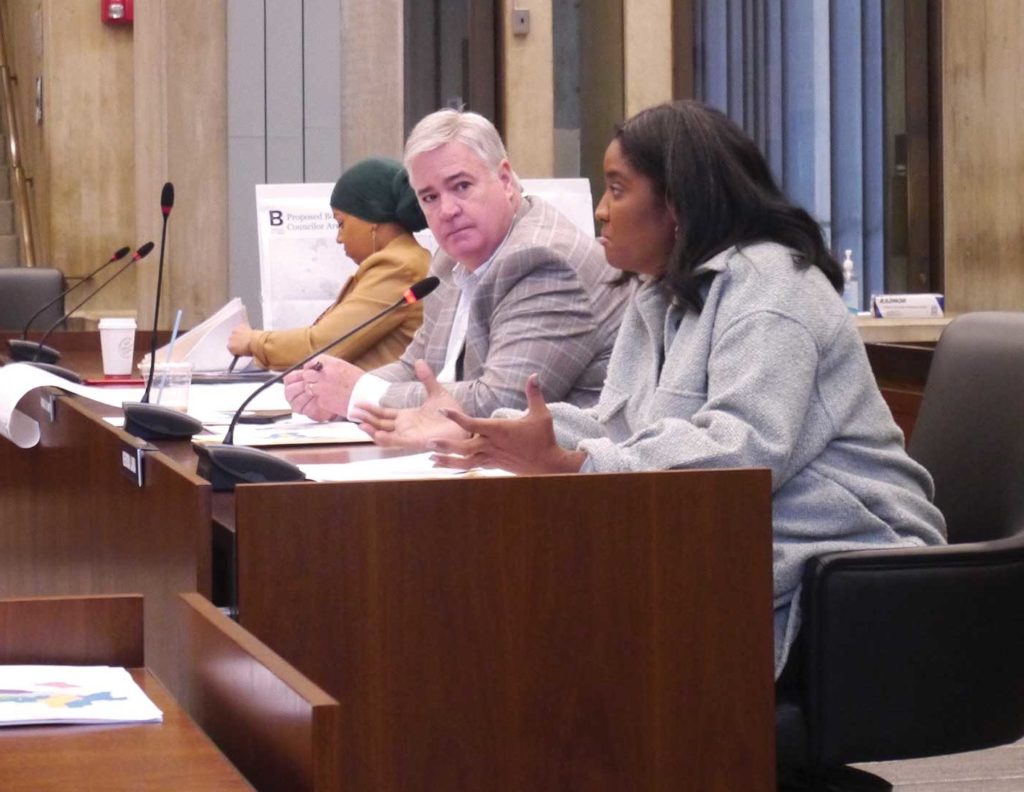Councilors debate 3 redistricting maps
Activists call for communities to stay consolidated in one district

Boston city councilors now have three proposed maps to consider in an ongoing redistricting process set to end in early November.
Last week, at-large Councilor Erin Murphy proposed a map, and this week Councilor Liz Breadon, acting chair of the Redistricting Committee, and Brian Worrell, committee vice chair, added their own take on the puzzle that determine where Boston voters cast their ballots for the next ten years. Happening once a decade, councilors are under pressure to create maps that are close to the city’s ideal average of 75,071 people in each of the nine districts.
Both of the recent proposals go up against a map drawn by ousted chair Councilor Riccardo Arroyo and Councilor Tania Fernandes Anderson.
District 2 — which is currently represented by Council President Ed Flynn — has seen some of the most population growth of any area over the last few years. Under the Breadon/Worrell map, District 2 would retain nearly 78,000 residents, meaning it would need to shed 3,000 voters in order to become more equal.
Significantly, the Arroyo-Fernandes Anderson map separates Chinatown, represented by Flynn, from the South End — a move Chinatown activists say would weaken the political power of the Asian population in the area. It would consolidate areas of the South End into districts 3 and 7 — represented by Frank Baker and Fernandes Anderson respectively.
Activists, including Lydia Lowe from the Chinese Progressive Association (CPA), have repeatedly called for the unification of the Chinese and Asian populations in the area, including at a public hearing last Thursday evening.
“After decades of organizing together with other communities to increase opportunity for people of color in District 2, we ask that we pay attention to the balance of communities within District 2 and that in order to increase that opportunity, that we think the balance between South Boston and the rest of District 2 needs to be changed,” she said.
However, Fernandes Anderson, during the same meeting, defended the map, saying that the move keeps Cape Verdean communities together. Her colleague Kendra Lara added that the South End also includes other diverse populations like Latinos in Villa Victoria.
“I am continually impressed and always have been by the advocacy of CPA in the AAPI community in everything that they’ve been able to do. But we cannot say that Villa Victoria, little Puerto Rico, is a Chinese precinct,” she said.
There are nearly 1,000 Asian Americans living in Villa Victoria and the nearby Cathedral Boston Housing Authority development.
The other two maps put the South End and Chinatown together and shed areas of South Boston and downtown instead.
District 3, represented by Baker, would retain just 72,000 voters in the Breadon/Worrell map and would need to pick up 3,000 people in the precincts surrounding it.
The Arroyo-Fernandes Anderson map stretches District 3 to include a portion of the South End, while the other two maps stretch the district more into South Boston. The biggest difference in the Murphy map and the Breadon-Worrell map is the designation of Fields Corner and Cedar Grove between districts 3 and 4. Murphy’s map would split the two neighborhoods, and give some of Grove Hall to District 4, while the Breadon-Worrell map unites Fields Corner in District 3 and Cedar Grove in District 4.
Baker, however, has expressed dissatisfaction, saying that he feels targeted by his fellow councilors. He said as much in a working session Friday morning.
“I don’t think there’s much commonality in this district between the south and the north,” Baker said. “I’m from the mouth of the Neponset to the mouth of the Charles — give me a break.”
Baker’s comments are just one example of the tension that has marked the redistricting process in recent weeks. Backlash arose last month when the Boston Globe in a report claimed Arroyo, then-candidate for district Attorney, was twice investigated for sexual assault. He was removed from his chairmanship positions by President Flynn, despite never having been charged with any crime. Baker, on the other hand, once pled guilty to drug trafficking charges. He has not been removed from any committees.
Councilors also expressed concerns about “packing” districts, or consolidating people of color into a single district, therefore limiting their political power. The practice is prohibited by the Voting Rights Act of 1965 — the law meant to guide lawmaker’s decision making and encourage the creation of “opportunity districts” where diverse candidates can get elected. In District 4, Worrell currently represents a population that is only 10% white. Murphy’s map would reduce the white population to 4%.
During the hearing Thursday, activists and community members reiterated the importance of the Voting Rights Act as a guiding light for councilors and encouraged the body to increase the public’s involvement in the decision-making process.
“I feel like you all should do a better job of reaching out to the community,” said Priscilla Flint Banks, director of the Black Economic Justice Institute.
According to Councilor Breadon’s office, she and Worrell will continue to hold hearings and working sessions over the next few weeks. The council aims to finalize its maps before Nov. 7.







